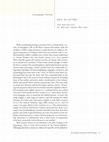Papers by Alexandra Pappas
Arethusa, 2014
Archilochus issues an iambic challenge to Kerykides through the frame of authoritative speech in ... more Archilochus issues an iambic challenge to Kerykides through the frame of authoritative speech in Epode 185W; the much-debated phrase akhnymenē skytalē is essential to that attack. I propose a new reading of akhnymenē that allows for its double-valence: it is at once "sorrowful" (as traditionally understood) and "speaking." This double meaning accords precisely with the dual strands of Archilochus' biting poetic mode: his words bring sorrow to their target in their verbal articulation. Such a reading also recommends my view of Archilochus' message stick as an analogue to Hesiod's iconic scepter, that is, as emblematic of Archilochus' authoritative iambic speech.
With a focus on the 7th-century BCE inscribed pots from Methone, this
chapter aims to clarify met... more With a focus on the 7th-century BCE inscribed pots from Methone, this
chapter aims to clarify methodological and theoretical approaches to early Greek inscribed objects by keeping the interrelationship between form, function, and content in balanced consideration. It illustrates the complexities inherent in assessing the relationship between the function of an object, the form of its inscription(s), and the content of its inscription(s), and urges careful consideration of each. It is argued that there is overall a symbiosis between the form and content of an inscription and the object’s function and use – whether for drinking vessels or for transport or storage vessels – and it is preliminarily
suggested that this analysis of early alphabetic inscriptions may apply equally to early non-alphabetic inscriptions.

When considering writing in ancient Greece, scholars from a variety of disciplines will recall Pl... more When considering writing in ancient Greece, scholars from a variety of disciplines will recall Plato's famous discomfort with the medium: it dulls a sharp memory; it easily deceives its audience, being the appearance of wisdom rather than true wisdom; and it is indiscriminately mobile, available even to those who cannot understand it. 1 Famed thinkers since the fourth century b.c.e. have queried Plato's diatribe against the written text but not always with consensus or satisfactory conclusion. I find it more useful, though, to widen the lens to examine the interdisciplinary relationship between ancient Greek words and images, which scholars from the traditionally independent disciplines of classical philology, epigraphy, art history, and archaeology have been slow to do. 2 Thus, we will not only better understand Plato but also the many who have responded both to the philosopher and to the ancient Greek tradition in general, including some of the authors and artists under consideration in this volume. Rather than probe Plato's notions in particular, then, this essay seeks to situate his criticisms within their larger cultural context-by posing new questions about how the Greeks used their alphabet when it first emerged in the eighth century b.c.e., and how those uses evolved over time until around the first century b.c.e., when Rome and its Latin language came to dominate the Mediterranean. As such, this study engages a wide range of evidence and will include the visible writings on archaic pots and statues (eighth to early fifth centuries b.c.e.), the classical Athenian stage (fifth century b.c.e.), and, of course, the page (third to first centuries b.c.e.). The representative sample of material and literary evidence presented here draws on a range of my interdisciplinary research and makes clear that, from their genesis, the Greek visual and literary arts were very much in active dialogue and interacted in a variety of fascinating ways to create meaning, sometimes in collaboration and at other times in competitive terms but consistently with reference to one another. 3
The great skill of a teacher is to get and keep the attention of his scholar; whilst he has that,... more The great skill of a teacher is to get and keep the attention of his scholar; whilst he has that, he is sure to advance as fast as the learner's abilities will carry him; and without that, all his bustle and pother will be to little or no purpose.











Uploads
Papers by Alexandra Pappas
chapter aims to clarify methodological and theoretical approaches to early Greek inscribed objects by keeping the interrelationship between form, function, and content in balanced consideration. It illustrates the complexities inherent in assessing the relationship between the function of an object, the form of its inscription(s), and the content of its inscription(s), and urges careful consideration of each. It is argued that there is overall a symbiosis between the form and content of an inscription and the object’s function and use – whether for drinking vessels or for transport or storage vessels – and it is preliminarily
suggested that this analysis of early alphabetic inscriptions may apply equally to early non-alphabetic inscriptions.
chapter aims to clarify methodological and theoretical approaches to early Greek inscribed objects by keeping the interrelationship between form, function, and content in balanced consideration. It illustrates the complexities inherent in assessing the relationship between the function of an object, the form of its inscription(s), and the content of its inscription(s), and urges careful consideration of each. It is argued that there is overall a symbiosis between the form and content of an inscription and the object’s function and use – whether for drinking vessels or for transport or storage vessels – and it is preliminarily
suggested that this analysis of early alphabetic inscriptions may apply equally to early non-alphabetic inscriptions.